Machu Picchu Travel Guide
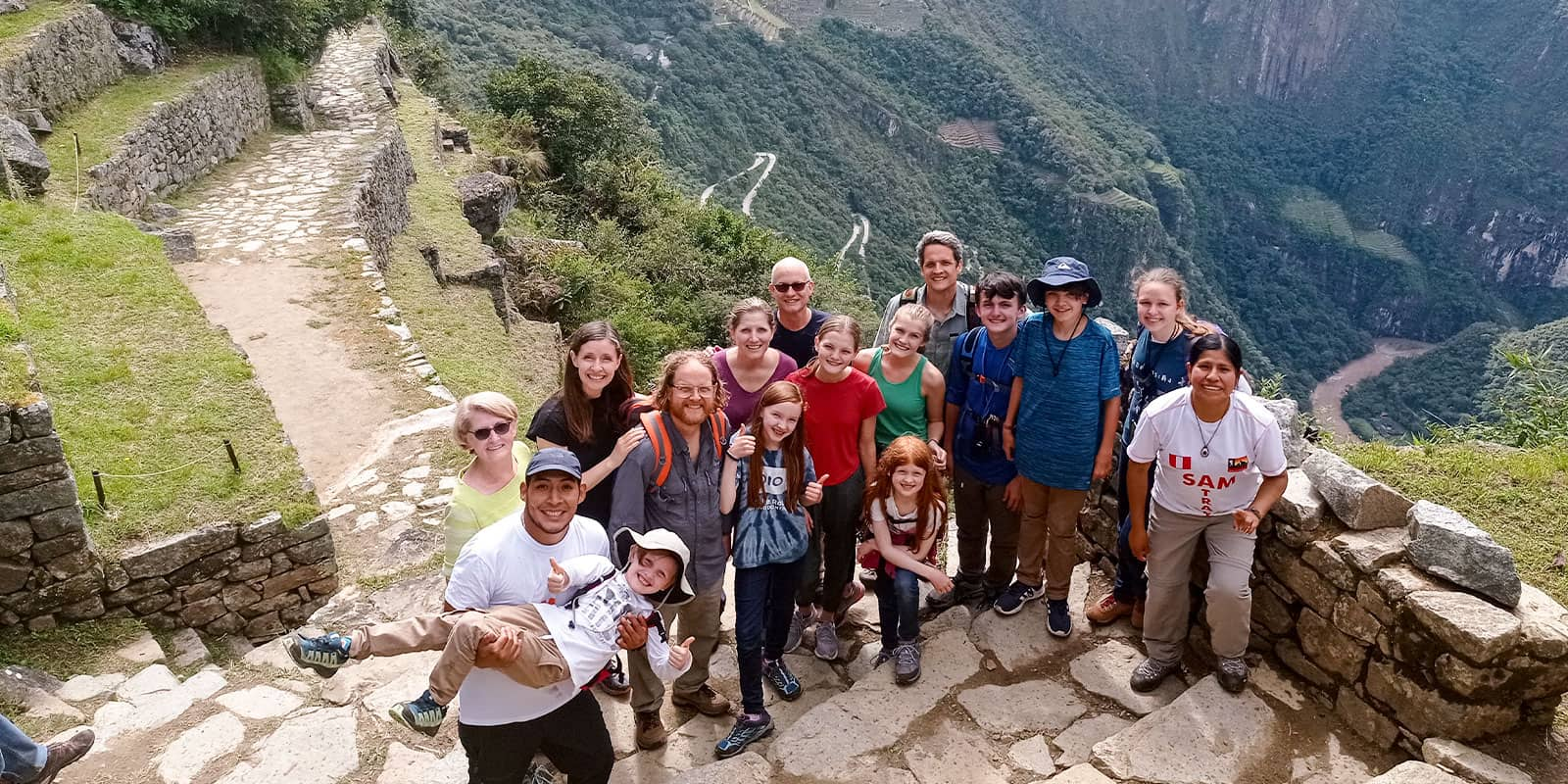
Machu Picchu is by far the most visited place in Peru, and it’s becoming one of the most popular places on the planet, making its way onto many bucket lists. It’s no surprise when you see its majestic sights in photos and pictures of the Incas hauling huge stones across a mountainside to build such an incredible place.
The archaeological site boasts certain energy that gives you chills when you look out over the scene. It’s easy to be transformed back in time and imagine everything that once went on there. There’s a lot of history to learn and a lot to explore.
Machu Picchu is a UNESCO World Heritage Site and one of the New Seven Wonders of the World. If you’re able to get to Peru and see Machu Picchu, it’s well worth the visit.
In this guide, we’re going to cover absolutely everything you need to know before you visit Machu Picchu, including information about the site and the best places to visit, where to eat and stay in the town, how to book your trip and get to Machu Picchu, as well as some essential tips and a packing list
Climate & Weather
Machu Picchu is at the intersection of the Andes and the Amazon, where the mild subtropical climate has warm days and cooler nights. Humidity is also higher than in Cusco and the Sacred Valley.
Dry Season and Rainy Season
Weather at Machu Picchu changes quickly and is unpredictable throughout the year. Similar to other high altitude destinations in Peru, the region has a dry and rainy season, but these conditions changes in the weather aren’t as clearly defined. The dry winter season for Machu Picchu is from April to October, and the wet summer season is from November to March. Remember, the northern and southern hemispheres experience opposite seasons.
Average Temperatures
Daytime: 68°F – 80°F (20°C – 27°C)
Nighttime: 50°F – 64°F (10°C – 18°C)
Best Time to Visit
The peak season for Machu Picchu is June, July, and August. These months coincide with the region’s dry season when sunny conditions are most probable and considered by many the best time to go to Machu Picchu. Hotels, entry tickets and other services fill up quickly, so make your reservations well in advance.
The low season for Machu Picchu is from December to February during the rainy season. There are fewer tourists and less crowding around attractions within the citadel. There is a much higher probability for rain, so don’t forget your raingear.
Geography & Map
Machu Picchu is located 50 miles (80 kilometers) northwest of Cusco in the Urubamba Province of Peru, where the eastern slopes of the Andes meet the Amazon Rainforest. The Inca built their city on a high mountain ridge overlooking the lush cloud forest surroundings. Far below, Urubamba River flows along the valley floor, past Aguas Calientes.
ELEVATION
7,970 ft (2,430 m)
NEW CIRCUITS TO VISIT MACHU PICCHU AFTER JUNE 1ST, 2024.
At the entrance, every visitor must show their ticket and passport. Students must also present their valid student ID here.
The duration of the visit is generally limited to a maximum of 4 hours. The only exceptions are tickets for the surrounding mountain peaks Wayna Picchu, Machu Picchu Mountain, and Huchuy Picchu, which allow for a longer stay.
The entry ticket entitles you to a single entry. It is not possible to leave and re-enter the citadel with the same ticket.
To enter Machu Picchu you will need a guide. You are not allowed to enter Machu Picchu without a guide. For a group of 10 or more, you require more than one guide.
You may not take large bags, professional cameras, groceries, and disposable bottles into the citadel. You can only carry one small bag with you. Walking sticks are only allowed for the physically challenged and elderly visitors.
New Circuits for Machu Picchu and New Routes
There are fixed routes through the facility with limited capacities to visit Machu Picchu. Below is an overview of the official routes.
Circuit 3 for Machu Picchu – Used mainly for hiking to the Sun Gate, Montaña or Inca bridge with view point included.
Circuit 1 A is for those who wish to hike to Machu Picchu Mountain. First you will hike to the Guard House above Machu Picchu, here you will get the perfect postcard pictures of Machu Picchu. The hike to Machu Picchu Mountain is around 3 hours round trip and is considered a moderate to difficult hike.
Circuit 1 B This is the shortest route at Machu Picchu, the hike includes the Guardhouse for great photo opportunities of the ancient Inca citadel, spend time enjoying the views spread before you.
Circuit 1 C is reserved for those who want to hike up to the Sun Gate or IntiPunku. The hike is about 2 hours roundtrip. The views of Machu Picchu are magnificent so be sure to have plenty of space on your phone to take photos. The gate was reserved for Royality and Nobles and you will see why when you take in the views of Machu Picchu.
Circuit 1 D for those who want to visit the Inca Bridge, this fascinating trek takes you past the beautiful scenery of the Andes and also the views of Machu Picchu are breathtaking.
Note, it is very important to note that all Circuit 1 tickets do not include a visit to the ruins of Machu Picchu. If you wish to visit you will need to buy an extra entrance ticket to Machu Picchu and a pay for guide.
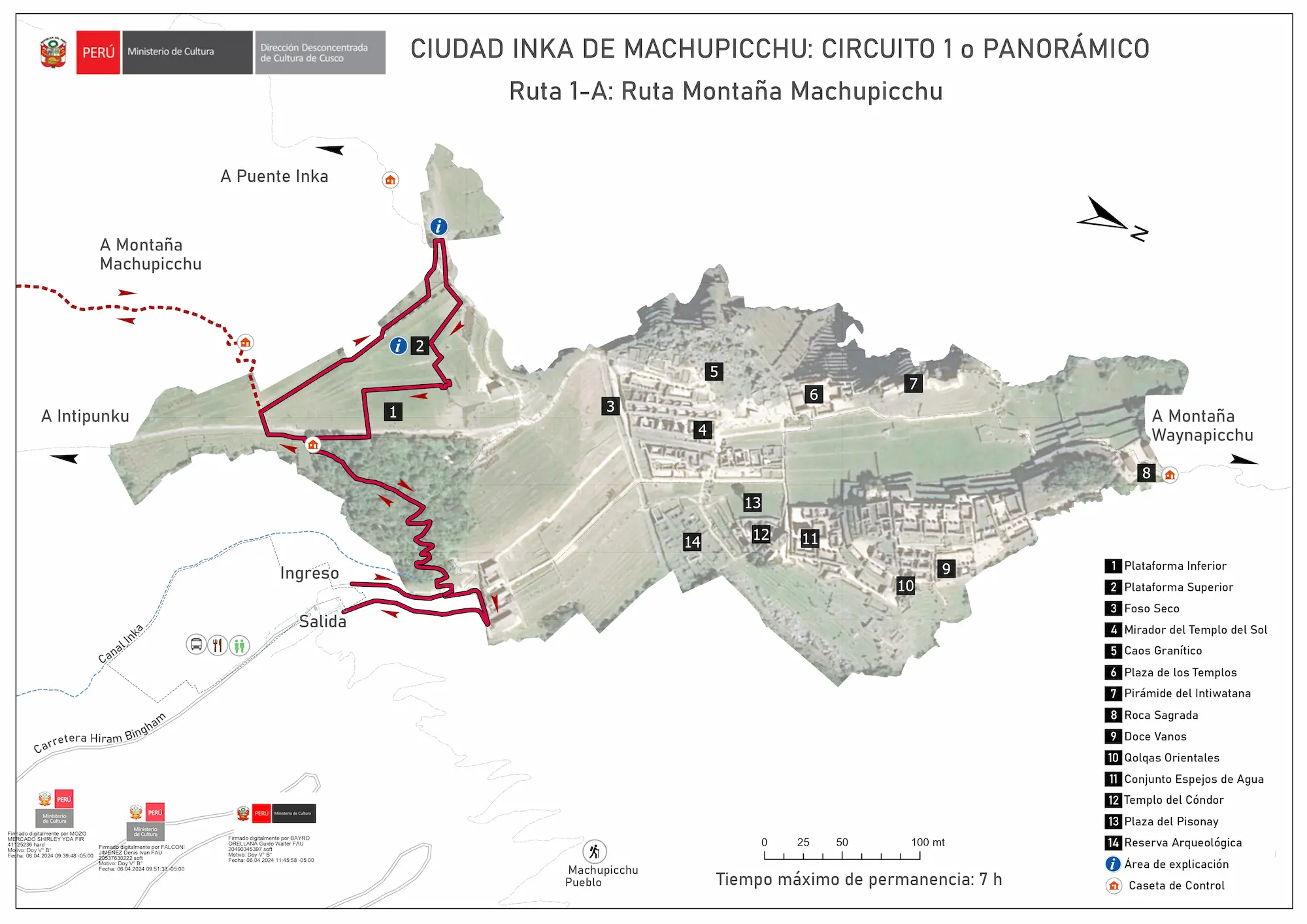
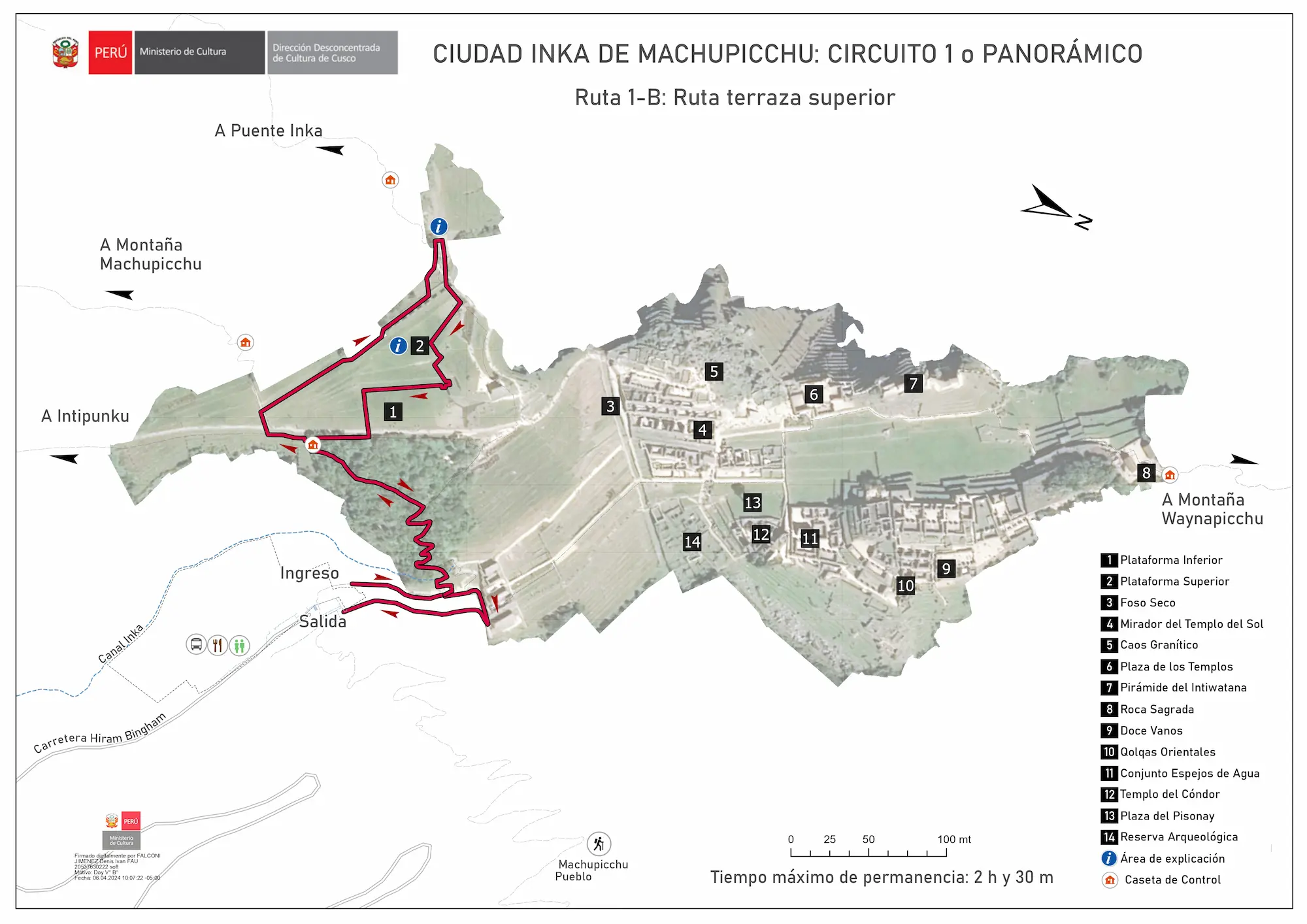
Circuit 3 for Machu Picchu – Best Circuit to Explore the city
Circuit 2A traditionally was the most popular with day trippers, as this Circuit explored the most sites of the ruin and includes the best views from the Guardhouse. The sites that Circuit 2 includes are Temple Plaza, The Sacred Rock, Temple of the Condor and the Pisonay Plaza, to name a few.
Circuit 2B, includes mostly the same sites as 2A and includes the best viewpoint for the postcard pictures below the guard house. This is where you get the great pictures of Machu Picchu.
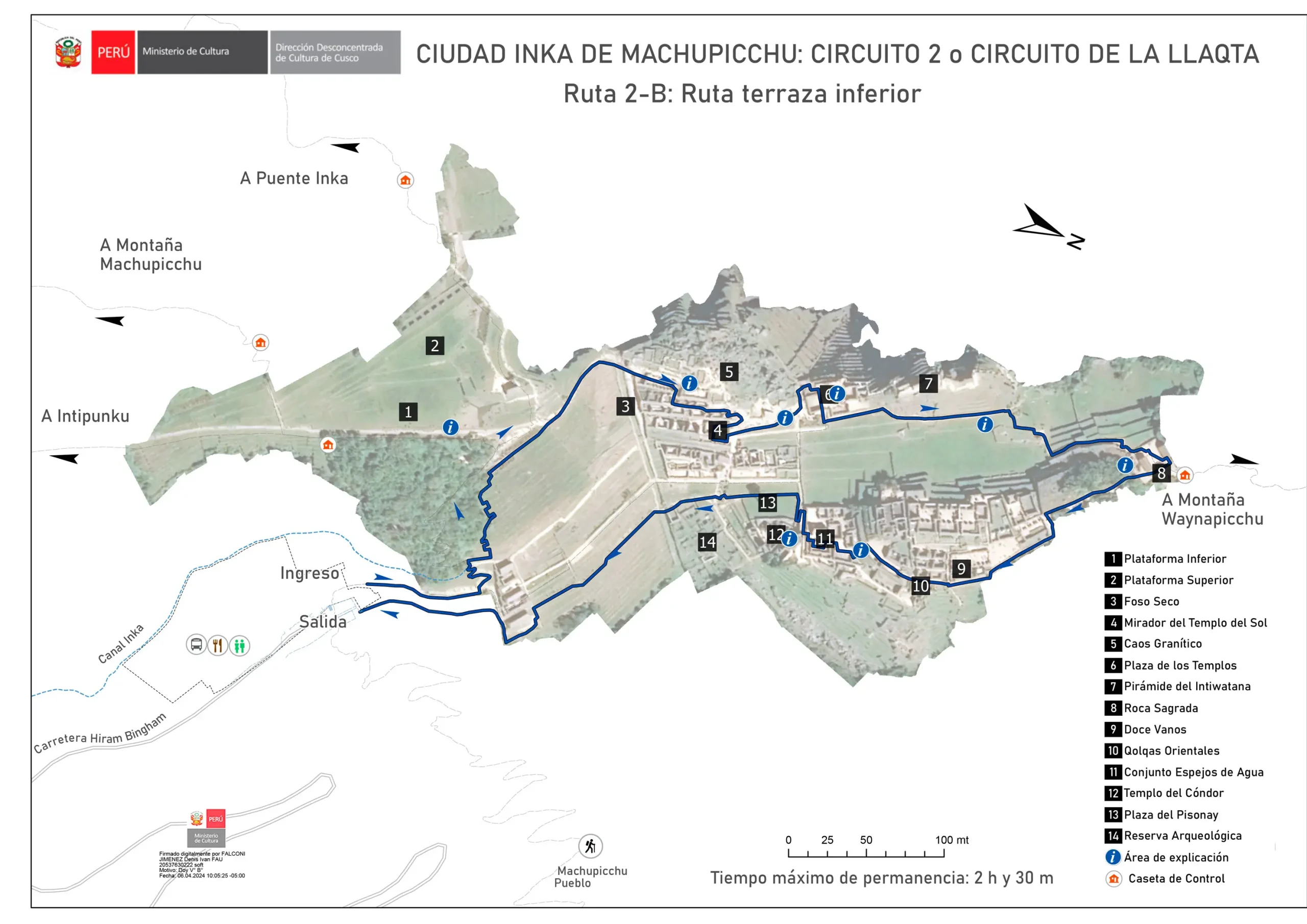
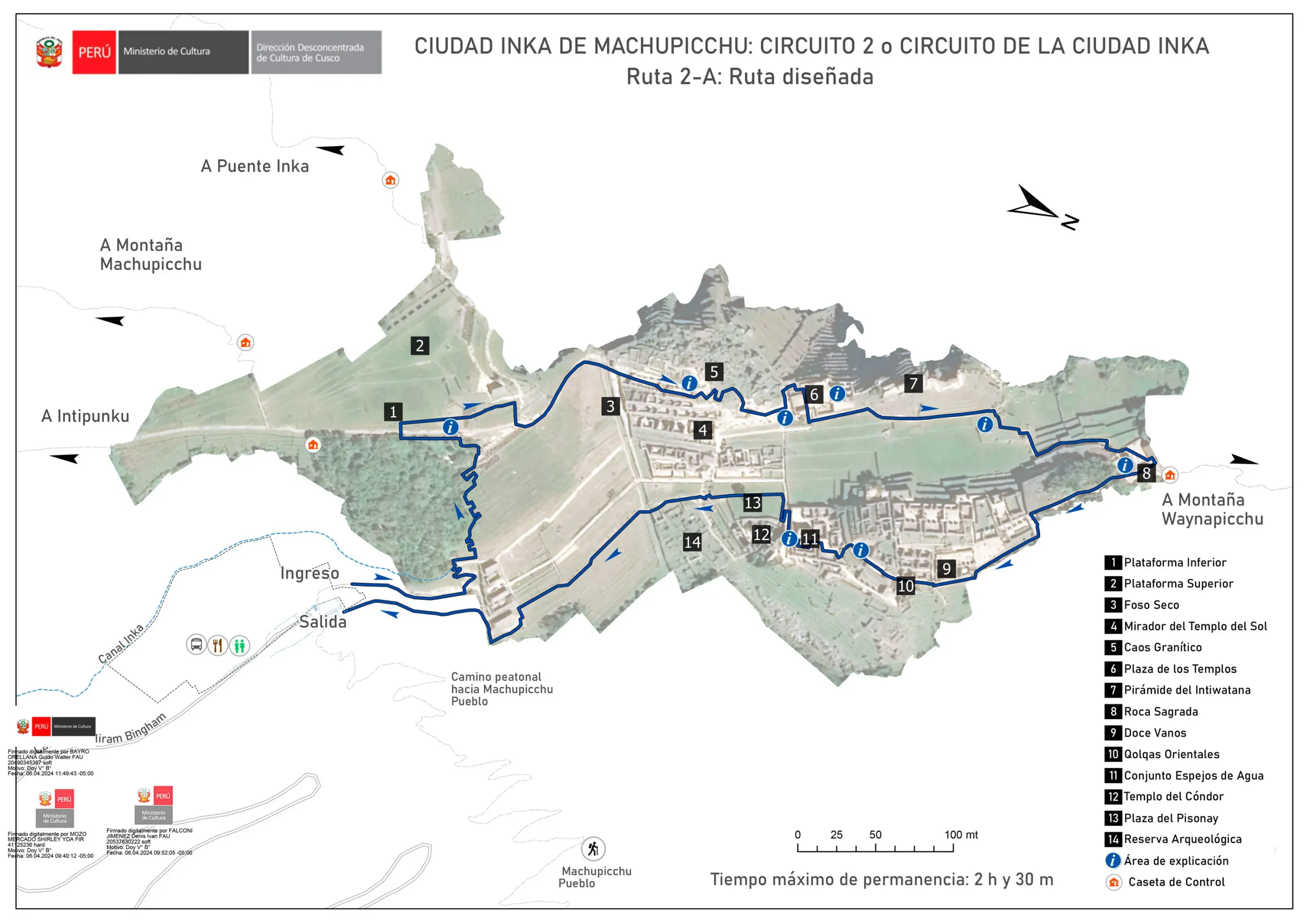
Circuit 3 for Machu Picchu
Circuit 3A this will include the lower part of Machu Picchu, not including the Guardhouse view point of Machu Picchu. This circuit is used by all 1, 2, 4 and 5 Inca Trail hikers. Sites you will see on Circuit 3 are The Stone Houses, The Farming Terraces, The Water Mirrors, The Temple of the Sun, The Work Shops, The Temple of the Condor, The Inca House and the Royal Houses. This circuit also includes an entrance to Huayna Picchu mountain, the cone shaped mountain that you see in all the postcards. The hike roundtrip is 2 hours.
Circuit 3B, this circuit includes the lower part of Machu Picchu only. Visit the sites of Temple of the Sun, The Inca House and the Temple of the Condor. You will need a guide to complete your tour of Machu Picchu.
Circuit 3C, again this circuit visits the lower part of Machu Picchu including the sites mentioned above. A visit to the Big Cave is included on this ticket.
Circuit 3D, this circuit take you to Huchuy Picchu Mountain. A short hike that is new to the Machu Picchu area. The site has great views and does not take a lot of effort. As part of circuit 3D you will visit the lower part of Machu Picchu with a guide
The Lower Circuits at Machu Picchu do not provide the best views from the top of the Inca Site.
Whats time Machu Picchu is open.
Machu Picchu is open to visitors daily from 6:00 to 17:30. Visits are not possible outside of these times. When purchasing the admission ticket, a fixed time slot of 60 minutes must be selected for admission. This cannot be changed after it has been issued.
THINGS TO DO?
Sun Gate, or Inti Punku in Quechua, of Machu Picchu, was once a guardhouse and principal entrypoint to the citadel
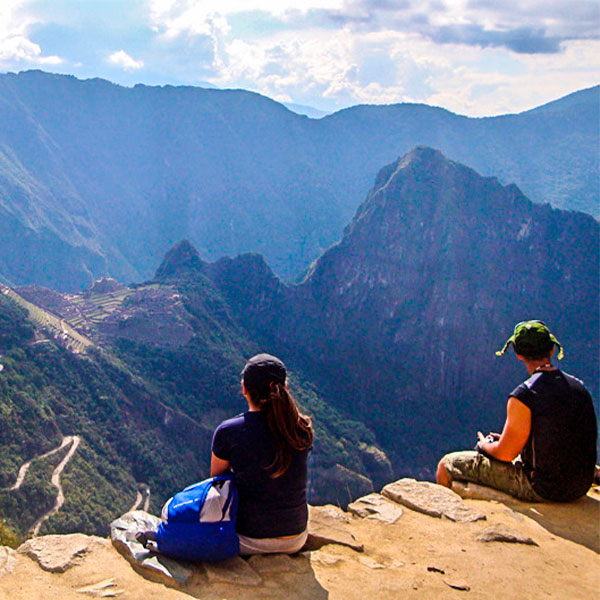
Sun Gate
The Sun Gate, also known as Inti Punku, was the original entrance to Machu Picchu. Today trekkers make their grand entrance to the citadel through the Sun Gate on the final day of the Inca Trail.
Huayna Picchu
The footpath leading up Huayna Picchu, the dome-shaped peak rising behind the Inca citadel, is the most popular hike at Machu Picchu. It takes about one hour to reach the summit of Huayna Picchu, and stunning views over the ruins are your reward. Higher sections of the trail are narrow with steep drop-offs, so you shouldn’t do this hike if you are afraid of heights. Entry for this trail is limited to 400 hikers per day and you must reserve your spot (if space is still available) when you purchase an entry + hike ticket in advance.

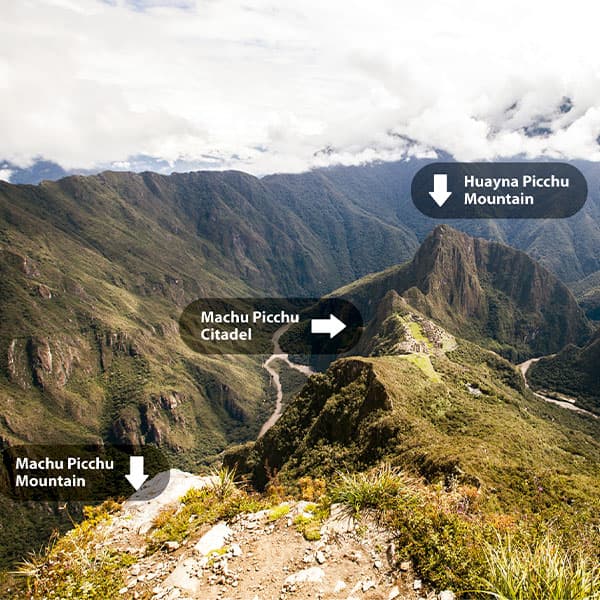
Machu Picchu Mountain
Montaña Machu Picchu is another hike at the Inca ruins and nearly double the height of the adjacent peak called Huayna Picchu. The one and a half to two-hour journey to the top is a strenuous climb with several long sections of stone steps and a spectacular 360-degree view awaits you at the summit. Access to Machu Picchu Mountain is also limited, and you must reserve your spot in advance when you buy an entry ticket + hike ticket.
Temple of the Sun
The Temple of the Sun is easy to pinpoint at Machu Picchu because it is the only semicircular structure. On the winter solstice, the southeast facing window of the temple aligns with the direction of the rising sun and illuminates the sacred rock in its center. Many scholars believe the temple was used by high Inca priests to honor Inti, the sun god.
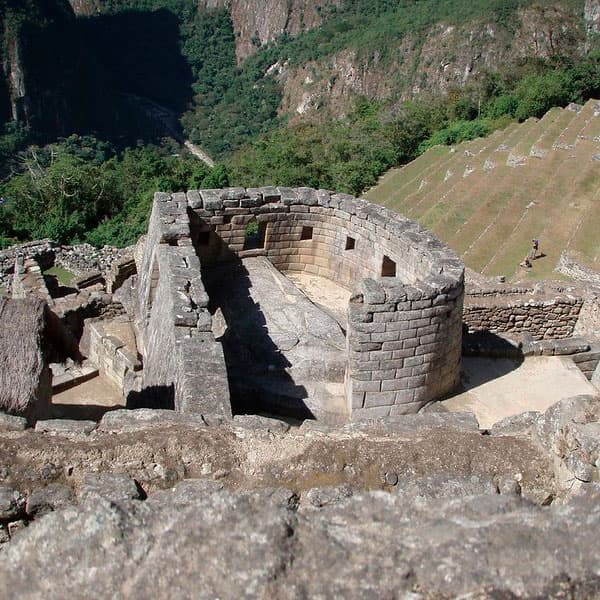

Intihuatana
The Intihuatana was chiseled out of a larger piece of granite rock and presumably used for casting shadows for astronomical observations. In the Quechua language, Intihuatana translates to “a place to which the sun is hitched,” which is a direct reference to the positioning of the rock structure at a high point within the Machu Picchu.
Sacred Rock
The Sacred Rock is a massive granite monolith positioned just before the beginning of the checkpoint for Huayna Picchu. The top of the rock has been carved to mirror the silhouette of Yanantin Mountain across the valley from Machu Picchu. For the Inca, the surrounding mountains were sacred spirits and the Sacred Rock may have been a place for spiritual ceremonies.
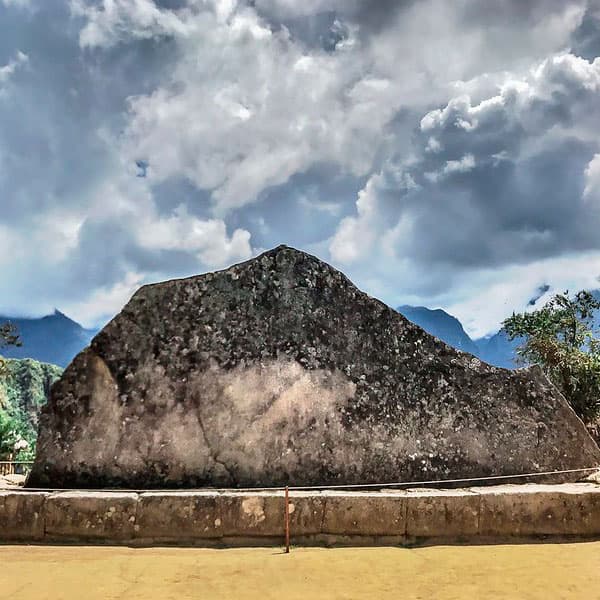
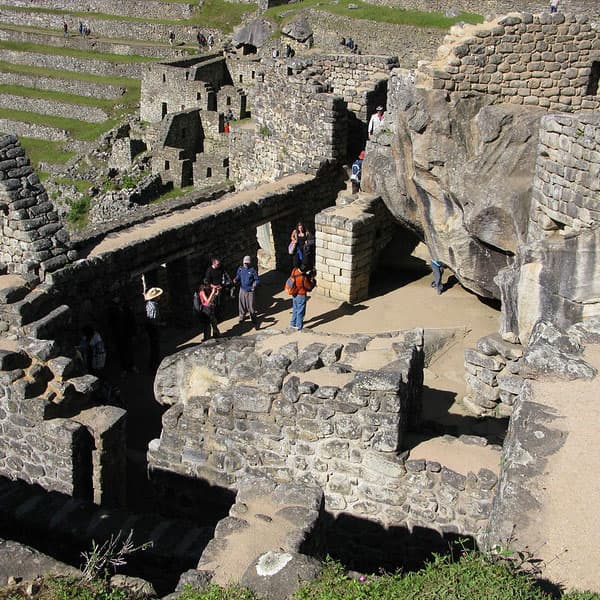
Temple of the Condor
The Temple of the Condor showcases how the Inca used natural rock formations to extract spiritual meaning. Using two granite boulders resting as angles for the bird’s outstretched wings, the Inca placed stones on the ground for its head and neck feathers and enhanced the temple with stone walls. Some scholars speculate the head of the condor functioned as an altar. A mummy was found in the natural cave chamber underneath one of the condor’s wings, suggesting the site was for burial purposes.
Stairway of Fountains
The Inca built a system of canals to carry water to the city’s agricultural and urban sectors using water from natural rain-fed springs on the north face of Machu Picchu Mountain. At the centerpiece of their intricate hydraulic system is the “Stairway of Fountains” through which water continues to flow. These sixteen fountains are linked together by stone channels and cascade down the mountain. Machu Picchu is a city comprising over 170 buildings, more than 600 terraces, thousands of stone steps, temples and 16 fountains.
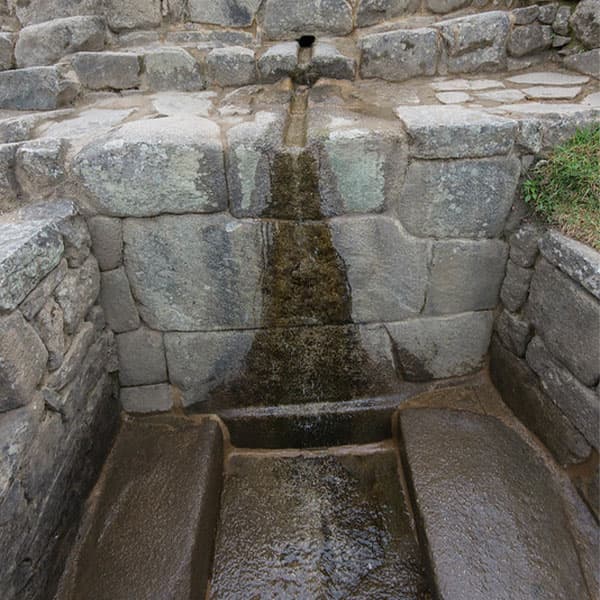
How to Get From Cusco to Machu Picchu?
The distance from Cusco to Machu Picchu, Peru, is just 75km. However, this 75 km will take you more time than it takes to travel the same distance on a freeway or by an Amtrak train because the route goes through the Andes.
But don’t worry. You can easily travel to Machu Picchu by train. The train leaves from the town of Poroy near Cusco. And since Cusco has pretty congested traffic, you need to make sure that you leave the city in advance and reach the train station in time.
It would drop you at Aguas Calientes train station, from where you can take a bus to the top.
You also need to buy the tickets beforehand as the tickets are almost always sold two weeks in advance.
Routes & Travel Times:
- The train from Cusco to Machu Picchu is 4 hours
- The train from Ollantaytambo to Machu Picchu is 2 hours
- The train from Urubamba to Machu Picchu is 3 hours (*limited weekly departures)
Train Luggage Restrictions:
You have to travel light when you take the train to Machu Picchu because storage room onboard is limited. Each passenger is only allowed one carry-on luggage that weighs no more than 11 lbs (5kg). Many hotels in Cusco and the Sacred Valley offer free luggage storage, where you can leave a separate bag filled with belongings you won’t need for this leg of your trip
Trekking to Machu Picchu
Adventurous travelers should trek to Machu Picchu! Trekking packages are organized so you trek to the famous archaeological site and return by train on the return leg of your journey.
The iconic 4-day Inca Trail to Machu Picchu is the most popular trek in South America. The journey takes you through high Andean passes, past lesser-known Inca sites and culminates with a memorable entrance to Machu Picchu through the Sun Gate. There’s also the 2-day Inca Trail if you are on a tight schedule or prefer a less demanding walk.
To hike the Inca Trail, you must reserve a permit in advance. There are wonderful alternative treks to Machu Picchu that don’t require a permit if Inca Trail permits are already sold out.
The 5-day Salkantay Trek is an excellent alternative trek to Machu Picchu for travelers who appreciate nature. This Andean trail passes by the imposing snow-capped Salkantay mountain, for which the trek is named, crosses highland pampas before dropping down into a river valley cloud forest and then onto Machu Picchu. Read more about the Salkantay Trek.
The 4-day Lares Trek is another alternative recommended for trekkers whose interest lies in cultural immersion. Follow a route through the Lares Valley, passing remote villages with rich Andean traditions, beautiful mountain scenery and lesser-known Inca ruins before touring Machu Picchu on the final day. Read more about the Lares Trek.
Hotels
Options for Machu Picchu hotels range from 5-star luxury resorts to budget dorms and everything in between. Machu Picchu Sanctuary Lodge is the only hotel up on the mountain next to the main entrance of the archaeological complex. All other accommodations are in Aguas Calientes and walking distance from the train station.
It’s possible to make a whirlwind Machu Picchu trip in one day. Still, we recommend enjoying this highlight of your trip at a slower pace, if possible. Staying a night or two in Aguas Calientes spaces out the legs of transport to and from Machu Picchu and helps you stay rested for an active day of touring.
- 5 Star Belmond Santurary Hotel at the Gate of Machu Picchu
- 5 Star Sumaq in Aguas Calientes
- 4 Star Casa del Sol in Aguas Calientes
- 4 Star Inkaterra Machu Picchu Pueblo in Aguas Calientes
- 3 Star Hotel Ferre Boulevard in Aguas Calientes
- 3 Star Hotel Pucara Machu Picchu in Aguas Calientes
Restaurants
Eating options outside the entrance to Machu Picchu are convenient, though limited. You can take a pre-made box lunch with you to Machu Picchu (available options depend on your itinerary), eat a buffet lunch at Belmond Sanctuary Lodge, or grab a quick bite at the Machu Picchu Snack Bar.
- Buffet at Belmond Sanctuary Lodge, at the gate of Machu Picchu]
- Indio Feliz, Peruvian, Latin Food in Aguas Calientes
- Ponchos Food and Wines, Peruvian Fusion, in Aguas Calientes
- Inka Wasi Restaurant and Pizzeria in Aguas Calientes
- Terraza Restaurant and Coffee Bar, Italian, Mexican in Aguas Calientes
WHAT TO BRING?
What to Bring to Machu Picchu
Here is an essential Machu Picchu packing list:
- Passport and Entry Ticket
- You need to present both documents at the entrance gate. Bring your original passport.
- Daypack
- Only small backpacks can be brought into Machu Picchu.
- Water
Fill up your reusable water canteen or buy bottled water to bring in your daypack to stay hydrated as you walk around Machu Picchu, especially if you do the Huayna Picchu or Machu Picchu Mountain hikes.
Clothing
Weather changes quickly at Machu Picchu, so it is best to dress in layers so you can add or remove layers as needed. Cloudy conditions quickly turn sunny and vice versa.
Sun Protection
The sun is very strong at Machu Picchu’s high elevation, especially from June to August during the peak of the dry season. Bring sunglasses, sunblock, and a hat.
Rain Protection
During the wet season from November to March, pack a rain poncho or travel-size umbrella in your daypack to be prepared for any unexpected showers.
Footwear
Comfortable hiking boots or athletic shoes with good traction are best for walking around the stone steps at Machu Picchu.
Camera
A camera with a zoom lense gives you more flexibility to capitalize on different angles and capture stone ruins far away.
What NOT to Bring to Machu Picchu
Camera tripods, selfie sticks, walking sticks, hiking poles and drones are not allowed inside Machu Picchu.
Luggage and large backpacks are not allowed. Many hotels offer complimentary luggage storage. There are also storage lockers at the entrance of Machu Picchu.
Alcohol is not allowed.
Baby strollers are not practical with all the stairs at Machu Picchu. Instead, a baby backpack style carrier is recommended.